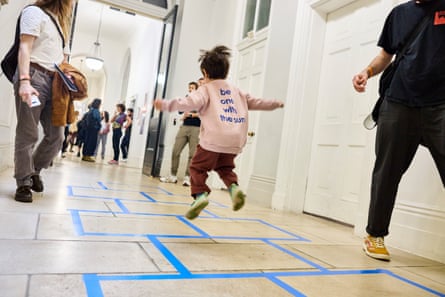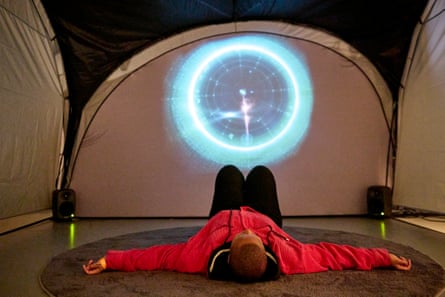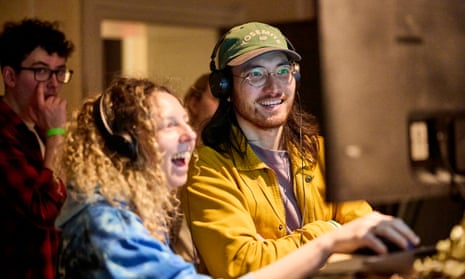Video game conventions are typically boisterous affairs, as thousands of visitors queue under a constellation of screens for the chance to play one of the hundreds of as-yet unreleased titles on display.
Now in its 10th year, Somerset House’s Now Play This is to mainstream exhibitions what folk festivals are to raves. None of the experimental games presented here are destined to be advertised on the sides of buses, not least because many are one-offs that use bespoke controllers – a hatching of thick ropes and copper bands, or an old suitcase lined with speakers – connected to laptops via an umbilical tangle of wires. Few of these games adhere to the conventional rules or fashions seen in mainstream video game design, either. They might have no “win state”, or provide an “open play” tool set with which visitors can create their own rules. The eccentricity is the point. You’ve played those other games, the programme suggests: now play this.
This year’s theme of liminality is fashionably chosen. Liminal spaces – places that exist at the threshold between two states – has become a popular hashtag on social media, even if it’s a term most usually applied to a general vibe rather than any anthropological criteria. Existing between the real and the imagined, video games are arguably all liminal spaces, but these exhibits go beyond a mere shared aesthetic. In artistic director María Luján Oulton’s phrase, they aim to provide space for “activism, creation and reconfiguration of the world”. In Beyond the Garden, for example, artist Laura Palavecino revisits a fauna-rich forest where she spent her childhood on the outskirts of Buenos Aires. The work is a melancholy recreation of a lost world. “Today,” she writes, “it is hard to see any of these animals which once flew and leapt around us.”
Concessions have been made to ease in newcomers. In the first room you find Crashboard, in which you stand on a real skateboard and lean left and right to control your avatar, who surfs through a glitching cyberspace on the vast projector screen in front of you. Mainstream game publishers explored precisely this kind of interface at the height of the Nintendo Wii’s popularity, so it’s a reassuringly recognisable entry point.
So too is The Edge of the World by Natalie Maximova, a video work (not every exhibit is strictly interactive) based on exploring the edges of the commercial video game Cyberpunk 2077, where the virtual world flattens and dissipates. It’s a machinima, one of several pieces that remix or reinvent existing work. Serafín Alvarez’s 2014 Maze Walkthrough provides another arresting example, with its endless warren of interlinking corridors, each one recreated from science fiction films such as Forbidden Planet, Event Horizon and Ender’s Game.

Some of this year’s exhibits are culturally familiar. Collectarium’s Hopscotch – easily the most lo-fi exhibit – has been taped on to the floor of a corridor, a reference to how, during lockdown, our homes became the stage on which a transition between two social phases played out. Andrew Sheerin’s Memorygame for Forgetfulness/ Memorygame for Remembrance is essentially the card game Concentration – except the images on the reverse of the oversized cards are satellite imagery from conflict zones in the Middle East. Less familiar is Martin Bonadeo and Oliverio Duhalde’s Astro.Log.IO, in which you provide your initials, the date, time and location of your birth, then squat in a tent to listen to “the sonification of your natal sky” – an eerie return to the celestial context of your own start point.
after newsletter promotion

Visitors hoping for a glimpse of the latest blockbusters, or escape room-style puzzles, will leave dissatisfied. Now Play This answers the question: what if geeks went to art school? Fittingly for an event about interactivity, the festival rewards those who engage rather than merely observe. And as the behemoths of video game publishing continue to narrow the field of what video games can be, and every release appears to be an attempt to recreate the success of a Fortnite or Call of Duty, how refreshing to see the breadth and brilliance of what interactive art can be away from the ruthless demands of commerce.

Comments (…)
Sign in or create your Guardian account to join the discussion